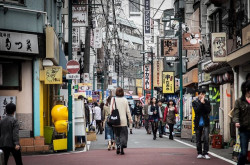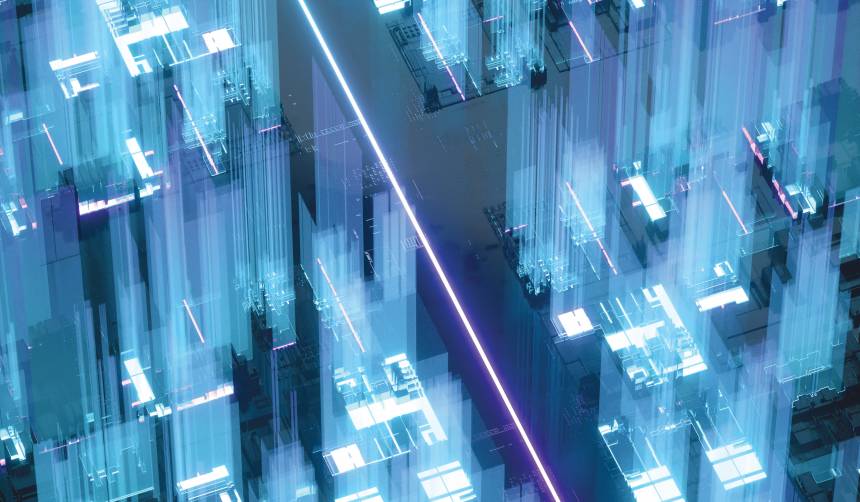
April 3, 2017
Talking AI at The Nobel Prize Dialogue Tokyo 2017
Will Japan lead the AI revolution?
By Angela Qian
2004’s I, Robot envisioned a future in which humans have advanced robot servants who develop the intelligence to rise against their creators. In 2013, Her imagined tech users falling in love with their artificially intelligent operating systems. TV series Black Mirror’s 2014 special “White Christmas” introduced simulated human personality replicas called “cookies” who think, act and behave virtually indistinguishably from their human originals, used as everything from personal assistants to subjects in police procedurals.
The AI future dreamed of in the not-so-distant past may be at our fingertips. In an article originally published on Foreign Affairs, Klaus Schwab, founder and executive chairman of the World Economic Forum, explains that we are on the precipice of a coming technological revolution—known as the Fourth Industrial Revolution—which will fuse physical, digital and biological technology in a paradigm shift that will revolutionize productivity levels and society as we know it. “The Fourth Industrial Revolution has the potential to raise global income levels and improve the quality of life for populations around the world,” he writes. “[It]…will change not only what we do but also who we are. It will affect our identity and all the issues associated with it.”
On February 26, 2017 it was this revolution that took front and center stage under the sleek glass roof of the Tokyo International Forum, along with an impressive roster of speakers: five Nobel Laureates; leading academics and researchers from institutions such as the California Institute of Technology, The University of California at Berkeley, The University of Tokyo and Carnegie Mellon University; executives and directors from companies including IBM, Sony, Google and Yahoo; government policy-makers; and one Zen Master and Chief Abbot. The event was the Nobel Prize Dialogue Tokyo 2017; the topic: The Future of Intelligence.
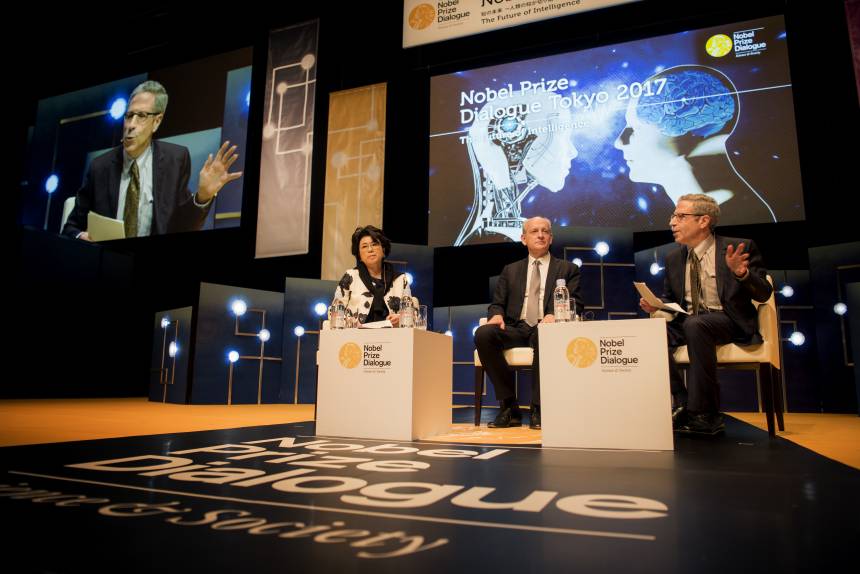
During a lecture on technology, economy and society, Japanese Business Federation Chairman Sadayuki Sakakibara explained that last year the Japanese Council for Science, Technology and Innovation (CSTI) released their 5th Science and Technology Basic Plan. Its goals: to realize, by 2020, a super smart society by “merging the physical space (real world) and cyberspace” to create an environment “in which humans and robots and/or artificial intelligence (AI) coexist…offering finely differentiated customized services that meet diverse user needs.” The plan is being called Society 5.0.
In unrolling the Society 5.0 initiative, Japan is taking active steps to harness the accelerating developments in artificial intelligence, robotics, the Internet of Things and ICT (information and communications technology) to shape its society into a model of what a super-smart society may look like. Sakakibara declared that as part of Japan’s role as a leading innovator in contributing to the advancement of mankind, the 2020 Olympics will be a chance to showcase Tokyo as an example of a Society 5.0 to the watching global audience.
So is our future in four years going to look like the stuff of I, Robot, Her and Black Mirror? Well, not quite.
The “Society 5.0” moniker was coined because policy-makers believe the Fourth Industrial Revolution will signal a fifth iteration of human society. Atsushi Sunami, the Vice President of the National Graduate Research Institute for Policy Studies (GRIPS) and, as Special Advisor for CSTI, co-drafter of the Society 5.0 policy, describes the first four iterations as the ages of (1) hunting and gathering, (2) agriculture, (3) industry and mass production, and (4) the current stage of human society, the age of information.
Society 5.0 also sprang from the German “INDUSTRIE 4.0” policy (not to be confused with the Fourth Industrial Revolution). INDUSTRIE 4.0 is based on using sensor technology and big data to make “smart manufacturing.” While this model is really to maximize efficiency in industry, the Japanese Society 5.0 initiative puts people first instead of manufacturing, extending innovation to other sectors such as the service industry.
The most important steps being taken right now, Sunami says, are collecting and universalizing different sets of big data and encouraging innovation that would take advantage of that data. It sounds neither sexy nor extremely radical, but systematically linking a wide range of personal data is one the first practical steps being taken to lay the foundation for Society 5.0. People with access to this pool of data could use it to develop all sorts of new ideas, Sunami says, particularly in Japan’s service sector.
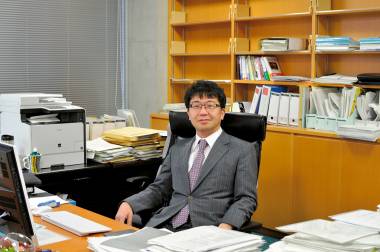
One example of possible service changes, for example, would be in driving. Sunami notes that in Taiwan, one ETC card can be used for gas, to buy snacks, and “do everything once you are on the road,” but in Japan there are several competing services: Japanese ETC cards get you on highways but not gas, and cards like the Suica are not universally accepted in Japan. “If everyone is using the same ETC system, we could use sensors to regulate or see if there are elderly driving, and so on,” Sunami says. “You can do all sorts of things with safety and driving.”
Another example he gave was of combining sensor technology with health data in intelligent cars. “The car would be able to tell you, look, I think your heartbeat is not so regular at the moment, why don’t you stop driving and get some rest?” or, “You don’t seem to be in a good mood today. Why not take an alternative route to your destination, maybe along the beach?”
According to Sunami, much of the data and technological developments necessary for these changes are already there or in the making. But as for how and when Japanese society can transition to a super-smart society, much depends on the government’s successful response to the growing pains of change. “First we have to work on the technology to link all this data,” Sunami says. “And also we need to change many rules and regulations.”
One of the largest concrete changes in the next few years, then, would be more regulatory rollback for entrepreneurs and businesses. One of Sunami’s roles is collecting feedback from entrepreneurs working on developing the new technology which they find inhibiting. He then approaches the relevant ministries and government offices to convince them to soften the existing regulations. A big part of the Society 5.0 initiative is targeted to make it easier for innovation to occur in science, technology and communications. For instance, Tokyo has been designated as a National Strategic Special Zone (in a law originally passed in 2013), which is intended to allow for relaxed regulations to promote innovation and business development.
Indeed, Sunami implies that the Japanese government is so heavily involved in the promotion of Society 5.0 because of the many regulations that need to be relaxed for innovation to happen. Commenting on different countries’ response to the Fourth Industrial Revolution, he says, “Each country has its own way of delivering things.” But “for Japan, I believe it is very important for the central government and Prime Minister to have a strong initiative…because particularly we need the government to change some things.”
Yet despite the annual goals set in CSTI’s five-year plan and the practical steps for groundwork currently being laid, it is an admittedly ambitious goal to get to Society 5.0 in the next three years. It requires not only investment in technology still under development but also, as Sunami says, “we have to work on almost re-engineering societal institutions…We have to change the way we live.”
Takamitsu Sawa, a distinguished professor at Shiga University, finds the stated goals of forming a super-smart society by 2020 to be “quite unrealistic.”
“Japan has been far behind the USA and Germany in developing technologies that would be indispensable to … a super-smart society,” he says over e-mail. “It is inconceivable for Japan to catch up to the USA in the next three years.”
In an opinion piece for The Japan Times in August 2015, Sawa expressed indignation over a notice from the education and science minister to abolish or downsize university humanities and social science departments in favor of fields “with greater utilitarian values.” The notice was the latest in a long tradition of Japanese neglect of the humanities and social science fields. It is precisely this neglect that has led to the decline in global rankings of Japanese universities; Sawa points out that top global schools such as the Massachusetts Institute of Technology, Stanford University and the University of Oxford are all highly reputable in the humanities and social sciences.
One of the reasons that Japanese innovation is slow, Sawa says, is that Japanese universities limit engineering courses to STEM—science, technology, engineering and mathematics. “Almost all engineers are lacking knowledge of liberal arts or of the humanities,” he writes in his e-mail. “As Steve Jobs pointed out, in order to stimulate innovation in the field of ICT, technology married with humanities or liberal arts is required.”
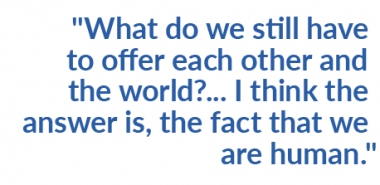
Sawa is not alone in thinking culture and the values promoted by humanistic fields of study will be important in the coming technological revolution.
Though the outcomes of CSTI’s 5th Science and Technology Basic Plan remain to be seen, expectations for the Fourth Industrial Revolution’s impact on human society remain radical. Economists and researchers have pointed out the Fourth Industrial Revolution’s potential to displace vast numbers of workers; Bill Gates even suggested a tax on robot-using employers as a negative incentive. At the Nobel Prize Dialogue Tokyo, Carnegie Mellon University professor Tom M. Mitchell explained it is highly likely the Fourth Industrial Revolution will skew the wealth distribution even further in favor of the rich. Lastly, he questioned how the technological revolution would impact our sense of self—“Intellectually, who am I,” he asked, “if a computer can do better anything that I am trying to do?”
The answers to this question tend towards assertions of “human” identity. Stuart J. Russell, a professor of computer science at UC Berkeley, predicts an increase in demand for humanities and social science because of the potential of those fields to enrich human lives. “What do we still have to offer each other and the world?” he asks. “I think the answer is, the fact that we are human…we will stop using humans as robots, and start using humans as humans.”
This could play out in the labor market with new types of employment. Sawa estimates that in Japan alone, the artificial intelligence revolution may increase income tax revenue by 170%—and with the increase in national income, governments could provide more public service employment opportunities in education, research, medical care and environmental protection.
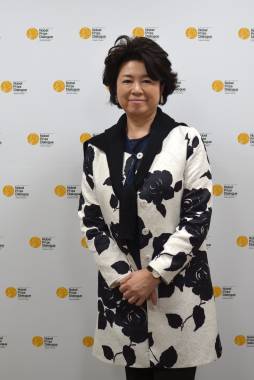
Indeed, optimists think that notions of labor and society could change in such a radical way as to render current fears of displaced workers unnecessary. “The development of artificial intelligence technology isn’t as replacing [of human labor] as people might think,” Sunami says. “There are a lot of things that people can just do better than current AI technology…except in conditions like simple manufacturing.”
But regardless, “There are people, of course, who question AI replacing [human] labor. But that’s the old concept. That’s Society 3.0…Maybe we can find new values in society.”
“In 10, 20 years from now, who knows,” he continues, “there may be totally different versions of a shared economy where making income doesn’t necessarily come with labor. Let the AI do all the profit-making and generating income, and we can just distribute the wealth. It’s a totally different concept. And we think, wait a minute, getting income without labor? What are you, what kind of society is this? But our next generation may find a way to live with this and be happy with that…And maybe this could be a new definition of work.”
Sawako Takeuchi, senior advisor to the Ministry of Education, Culture, Sports, Science and Technology, shares similar views with Sunami. The AI revolution could eliminate unnecessary work and create new jobs. As AI labor replaces human productivity, she envisions a future where humans would have far more physical freedom and the leisure to travel or work without being attached to a desk or office. “Our bodies can be liberated from a fixed job,” she says.
Takeuchi agrees with Sawa about the importance of cultural resources. “Creativity is very important for artificial intelligence creators,” she says, and opines that the government should invest more in such resources, in artists, producers and artisans.
Rather than fearing human worth will be replaced by robotics or AI, then, Takeuchi sees potential in the Fourth Industrial Revolution for ideas of human worth to be measured in terms of purely human qualities, such as our ability to use our five senses and appreciate beauty. “We are not creatures to work all the time,” she says. “We need a lot of time to rest and think and feel something beautiful. To cultivate beauty.”
A classical pianist of Chopin, Takeuchi says that AI can reproduce music that has already been played by an artist or pianist. But they cannot make it new or different. “I think AI can do something to reproduce or to duplicate but they cannot produce the kind of excitement or surprise [humans can]. That means we have to download different things all the time if we really want to get some excitement.

“Only human beings can play the same piece of Chopin differently. Each time they can change it slightly, according to the emotion.”
For Takeuchi it boils down to a single breath. “When there is a phrase in Chopin that is more important than the other parts, when we play it, we breathe. Very shortly. One second. And then play. And this goes for the audience as well. If they predict something will happen, they take a breath. And then they share the same kind of feeling [with the pianist].
“But computer and machines, they don’t need to breathe. They go quickly to the next phrase. So this, the duration of breathing, is very important for human beings.”
—
Ellis Kim contributed reporting. Nobel Prize Dialogue Tokyo 2017 Photos (c) Nobel Media AB. Photos by Alexander Mahmoud.






